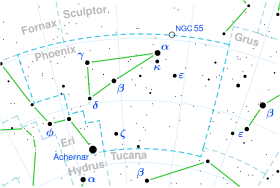Nu Phoenicis
| Observation data Epoch J2000 Equinox J2000 |
|
|---|---|
| Constellation | Phoenix |
| Right ascension | 01h 15m 11.12150s |
| Declination | –45° 31′ 53.9954″ |
| Apparent magnitude (V) | 4.95 |
| Characteristics | |
| Spectral type | F9 V Fe+0.4 |
| U−B color index | +0.09 |
| B−V color index | +0.57 |
| Astrometry | |
| Radial velocity (Rv) | +11.7 km/s |
| Proper motion (μ) |
RA: 665.13 ± 0.20 mas/yr Dec.: 177.63 ± 0.19 mas/yr |
| Parallax (π) | 66.16 ± 0.24mas |
| Distance | 49.3 ± 0.2 ly (15.11 ± 0.05 pc) |
| Absolute magnitude (MV) | 4.28 |
| Details | |
| Mass | 1.20−1.25 M☉ |
| Radius | 1.25 R☉ |
| Surface gravity (log g) | 4.30 cgs |
| Temperature | 6,069 K |
| Metallicity [Fe/H] | +0.02 dex |
| Rotational velocity (v sin i) | 3.7 km/s |
| Age | 5.7 Gyr |
| Other designations | |
| Database references | |
| SIMBAD | data |
Nu Phoenicis is a F-type main-sequence star in the southern constellation of Phoenix. It is visible to the naked eye with an apparent visual magnitude of 4.95. This is a solar analogue, meaning its observed properties appear similar to the Sun, although it is somewhat more massive. At an estimated distance of around 49 light years, this star is located relatively near the Sun.
Based on observations of excess infrared radiation from this star, it may possess a dust ring that extends outward several AU from an inner edge starting at 10 AU.
...
Wikipedia

